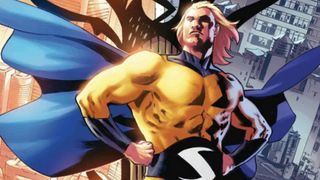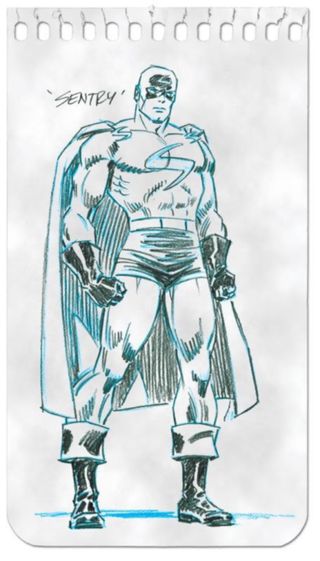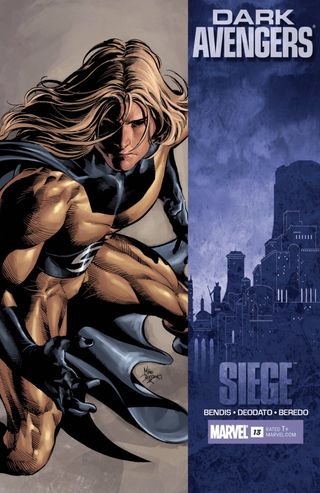Remember the Sentry, the character Stan Lee forgot he created?
Could the early 2000's gimmick character have a future in the MCU?

Way back in the '60s, Stan Lee and a relatively unknown artist named Artie Rosen created a Superman-like hero of near limitless power named The Sentry - though Lee and Rosen lost track of the character before ever using the idea.
After Rosen's death in 1999, contemporary writer Paul Jenkins uncovered Rosen's original sketches and brought them to Lee, thus a long lost original Marvel Comics character that had gone unseen since the early '60s was rediscovered, birthing the legend of the Sentry, the character that Stan Lee - and the entire Marvel Universe - forgot.
Except that's all bull$#!%.
In actuality, The Sentry was a brand new character conceived by Paul Jenkins, Rick Veitch, and Jae Lee, who was intended as a character who was once a part of the Marvel Universe, but who everyone from the Avengers, to the X-Men, and beyond totally forgot about.

But rather than simply selling the conceit that all the characters in the Marvel Universe had forgotten about the Sentry, Marvel pulled out all the stops, enlisting Stan Lee himself, then Marvel editor-in-chief Joe Quesada, and even the most popular comic publication of the time, Wizard Magazine, to sell the story that Lee had actually forgotten about the Sentry in real life as well.
This involved a series of interviews in Wizard in which Lee, Jenkins, and Quesada discussed how the Sentry was rediscovered, along with their plans to bring him "back" into the Marvel Universe with a story that would reveal how he had disappeared in the first place, as well as bringing in classic Marvel artist John Romita Jr. to create the sketches that were meant to have been drawn by fictional artist Artie Rosen, who was invented as part of the story of the forgotten creation of the Sentry.
Nonetheless, while fans had mixed reactions (and levels of awareness) about the so-called Sentry hoax, the character became a very real, and often controversial part of the Marvel Universe.
Comic deals, prizes and latest news
Get the best comic news, insights, opinions, analysis and more!
So who is the Sentry, really?
Who is the Sentry?

In Marvel Universe terms, he's Robert Reynolds, a young man who gains the incredible "power of a thousand exploding suns" after ingesting an experimental serum, which basically amounts to near limitless, Superman-like power.
However, there's a dark side to the Sentry's powers. Lurking inside Reynolds is a being known as The Void, an evil reflection of the Sentry whose powers of destruction are just as immense as Reynolds' own abilities, and who manifests when Reynolds' mental illness goes unchecked.
The original '00s Sentry limited series establishes that the Sentry was actually a Silver Age contemporary of heroes like the Avengers and the Fantastic Four. He disappeared from the Marvel Universe when his mind was wiped, along with the memories of everyone on Earth, to make everyone forget the Sentry had ever existed (kind of like how in the MCU Doctor Strange made everyone forget who Peter Parker is and that he is Spider-Man in No Way Home) - the only way to subdue the Void.
Once Sentry is reawakened in the Marvel Universe, he becomes a recurring fixture of the Avengers franchise, first as a surprise member of the New Avengers team, and eventually as a member of Norman Osborn's Dark Avengers.

Under Osborn's manipulation, Sentry is warped into something of Osborn's personal enforcer, in touch with his destructive Void persona and willing to carry out Osborn's most destructive ends.
This culminates in the story Siege, in which Osborn and the Dark Avengers, assisted by Loki, launch an attack on Asgard, which was then floating above the Earth. Though Loki believes Osborn intends to install him as Asgard's new ruler, instead Osborn activates the Sentry to use his incredible strength to destroy Asgard, bringing it to the ground in ruins.
Ares, the Greek god of war who was part of the Dark Avengers, attacks Sentry, but is completely ripped in half, showcasing Sentry's incredible strength. Sentry then also kills Loki himself, leading to Loki's eventual rebirth as Kid Loki.
(Not for nothing, 'The Void' was the name given to the place where Kid Loki and the other Loki Variants were trapped in the MCU Loki streaming series).
After Sentry/Void is defeated at the end of Siege, he's locked away again, though he's since resurfaced a time or two in the Marvel Universe, even briefly headlining his own short-lived ongoing title just a few years ago.
The Sentry in the MCU

Sentry hasn't come to the MCU, and as far as we know, there are no official plans just yet. However, unsubstantiated rumors have begun to pop up indicating that the Thunderbolts movie is searching for an "evil Superman" type to play its villain.
Along with Hyperion of the Squadron Supreme, Sentry seems to be one of the most likely candidates for inclusion as a villain for the Thunderbolts - especially considering their history with the Dark Avengers.
Would that mean bringing in an MCU version of Norman Osborn (alongside the one who was transported from Tobey Maguire's Spider-Man universe in Spider-Man: No Way Home, of course)?
Speaking of No Way Home, at the very least, Marvel has established a precedent that it's possible for everyone in the MCU to forget about someone through magical means, or Multiversal manipulation - a plot point that could easily be brought back for the Sentry.
Who knows. In fact, when it comes to the Sentry, thanks to his odd origins and the good-natured "hoax" tied to his introduction, there are almost nothing but questions surrounding the possible ways he could come to the MCU.
Read up on the best Avengers stories of all time.
I've been Newsarama's resident Marvel Comics expert and general comic book historian since 2011. I've also been the on-site reporter at most major comic conventions such as Comic-Con International: San Diego, New York Comic Con, and C2E2. Outside of comic journalism, I am the artist of many weird pictures, and the guitarist of many heavy riffs. (They/Them)
Most Popular







